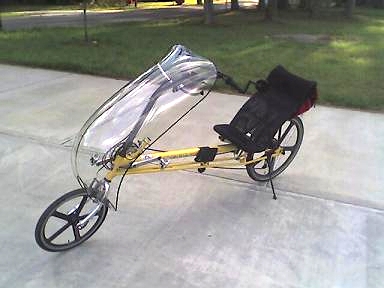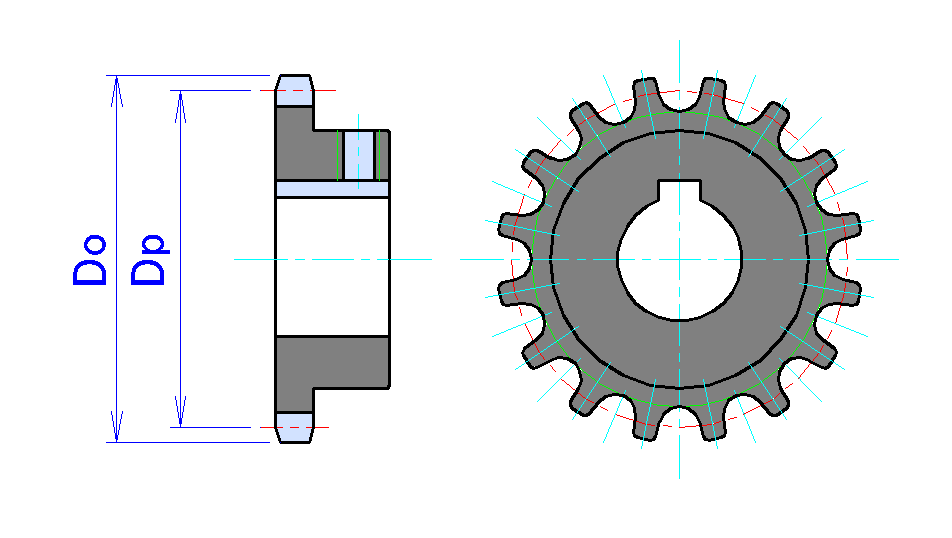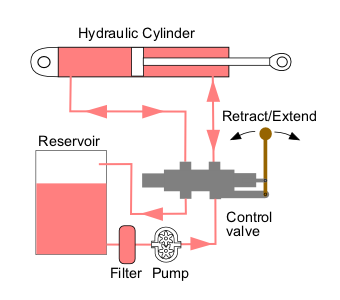|
Hydraulic Bicycle
A hydraulic bicycle is a chainless bicycle that transfers power to the pedals by means of a liquid passing through tubes from hydraulic pump to hydraulic motor and back. Advantages include: * Shifting, through valves and displacement, provides either continuously variable gearing or more steps than traditional bicycles. * Shifts smoothly under full power. * Drive transmits power while pedaling forward and backward. Thus racers can power bicycle through turns by alternating short forward and backward pedal strokes. No slack or backlash occurs, in either direction. Ability to coast is maintained. * Mechanism is clean and operates silently. * Fewer moving parts (about 10 vs over 70), all of which are continuously bathed in clean lubricating fluid. * Sealed systems require less maintenance than open chain system. * Front-wheel drive and two-wheel drive systems can be implemented. (See Two-wheel drive) * Drive can double as a hydraulic brake, eliminating the weight, cost, and maintenanc ... [...More Info...] [...Related Items...] OR: [Wikipedia] [Google] [Baidu] |
Chainless Bicycle
A chainless bicycle is a bicycle that transmits power to the driven wheel through a mechanism other than a metal Bicycle chain, chain. Examples * Directly driven "ordinary" bicycle (see penny-farthing) * Shaft-driven bicycle * Belt-driven bicycle * Hydraulic bicycle (and pneumatic bicycle) * Hybrid vehicle#Two-wheeled and cycle-type vehicles, Hybrid vehicle (see series hybrid bicycle) * Some Rowed vehicles#Drive train, rowed bikes use a cable or a linkage. * Stringbike the pulley-driven Hungarian designed bike See also *Bicycle drivetrain systems * Outline of cycling References * External links Cycle types {{Cycling-stub ... [...More Info...] [...Related Items...] OR: [Wikipedia] [Google] [Baidu] |
Two-wheel Drive
Two-wheel-drive (2WD) denotes Motor vehicle, vehicles with a Powertrain, drivetrain that allows two wheels to be driven, and receive Engine power, power and torque from the engine, simultaneously. Four-wheeled vehicles For four-wheeled vehicles (and by extension, vehicles with six, eight, or more wheels), this term is used to describe vehicles that are able to power at most two wheels, referred to as either front-wheel drive, front, or rear-wheel drive, rear-wheel-drive. The term 4x2 is also used, to denote four total wheels with two being driven. Most road vehicles use a 2WD layout due to its lightweight and simplicity. Traction on the road is usually sufficient that the driving force can be reliably transmitted through only two wheels. For vehicles that have part-time four-wheel drive, the term refers to the mode when 4WD is deactivated and power is applied to only two wheels. Two-wheeled vehicles For two-wheeled vehicles such as motorcycles and bicycles, the term is used to ... [...More Info...] [...Related Items...] OR: [Wikipedia] [Google] [Baidu] |
Recumbent Bicycle
A recumbent bicycle is a bicycle that places the rider in a laid-back reclining position. Most recumbent riders choose this type of design for ergonomic reasons: the rider's weight is distributed comfortably over a larger area, supported by back and buttocks. On a traditional upright bicycle, the body weight rests entirely on a small portion of the Tuberosity of the ischium, sitting bones, the feet, and the hands. Most recumbent models also have an aerodynamics, aerodynamic advantage; the reclined, legs-forward position of the rider's body presents a smaller frontal profile. A recumbent holds the world speed record for a bicycle, and they were banned from racing under the Union Cycliste Internationale (UCI) in 1934, and now race under the banner of the World Human Powered Vehicle Association (WHPVA) and International Human Powered Vehicle Association (IHPVA). Recumbents are available in a wide range of configurations, including: long to short wheelbase; large, small, or a mix ... [...More Info...] [...Related Items...] OR: [Wikipedia] [Google] [Baidu] |
Bicycle Chain
A bicycle chain is a roller chain that transfers power from the pedals to the drive-wheel of a bicycle, thus propelling it. Most bicycle chains are made from plain carbon or alloy steel, but some are nickel-plated to prevent rust, or simply for aesthetics. History Obsolete chain designs previously used on bicycles included the block chain, the skip-link chain, and the Simpson lever chain. The first chains were of a simple, bushing-less design. These had inherent reliability problems and a bit more friction (and mechanical efficiency losses) than modern chains. With these limitations in mind, the Nevoigt brothers, of the German Diamant Bicycle Company, designed the roller chain in 1898, which uses bushings. More recently, the "bushingless roller chain" design has superseded the bushed chain. This design incorporates the bearing surface of the bushing into the inner side plate, with each plate creating half of the bushing. This reduces the number of parts needed to assemble ... [...More Info...] [...Related Items...] OR: [Wikipedia] [Google] [Baidu] |
Sprocket
A sprocket, sprocket-wheel or chainwheel is a profiled wheel with teeth that mesh with a chain, track or other perforated or indented material. The name 'sprocket' applies generally to any wheel upon which radial projections engage a chain passing over it. It is distinguished from a gear in that sprockets are never meshed together directly, and differs from a pulley in that sprockets have teeth and pulleys are smooth except for timing pulleys used with toothed belts. Sprockets are used in bicycles, motorcycles, tracked vehicles, and other machinery either to transmit rotary motion between two shafts where gears are unsuitable or to impart linear motion to a track, tape etc. Perhaps the most common form of sprocket may be found in the bicycle, in which the pedal shaft carries a large sprocket-wheel, which drives a chain, which, in turn, drives a small sprocket on the axle of the rear wheel. Early automobiles were also largely driven by sprocket and chain mechanism, a practice la ... [...More Info...] [...Related Items...] OR: [Wikipedia] [Google] [Baidu] |
Hydristor
Hydristor is a joining of the words 'hydraulic' and 'transistor'. The device invented by Tom Kasmer in 1996 and is based on the dual pressure balanced hydraulic vane pump invented by Harry F. Vickers in 1925. Vane pump details The Vickers design included an elliptic chamber which confined the radial motion of the vanes nested in the rotor slots. As the rotor and vanes turn, each vane is first pushed radially inward followed by a maximum radial extension and that happens twice per revolution. The displacement of the fixed device is calculated by determining the difference in vane extension between minimum and maximum, times the axial length of the vanes and rotor. This multiplies to an area subject to the hydraulic pressure in the device whether used as a motor or a pump. Then an average of the minimum and maximum extensions establishes a 'radius of motion' for the pressurized equivalent pressure/force area. of each vane which passes one of the 4 axial sealing areas. What happens i ... [...More Info...] [...Related Items...] OR: [Wikipedia] [Google] [Baidu] |
Hydraulic Machinery
Hydraulic machines use liquid fluid power to perform work. Heavy construction vehicles are a common example. In this type of machine, hydraulic fluid is pumped to various hydraulic motors and hydraulic cylinders throughout the machine and becomes pressurized according to the resistance present. The fluid is controlled directly or automatically by control valves and distributed through hoses, tubes, or pipes. Hydraulic systems, like pneumatic systems, are based on Pascal's law which states that any pressure applied to a fluid inside a closed system will transmit that pressure equally everywhere and in all directions. A hydraulic system uses an incompressible liquid as its fluid, rather than a compressible gas. The popularity of hydraulic machinery is due to the very large amount of power that can be transferred through small tubes and flexible hoses, the high power density and a wide array of actuators that can make use of this power, and the huge multiplication of forces t ... [...More Info...] [...Related Items...] OR: [Wikipedia] [Google] [Baidu] |




